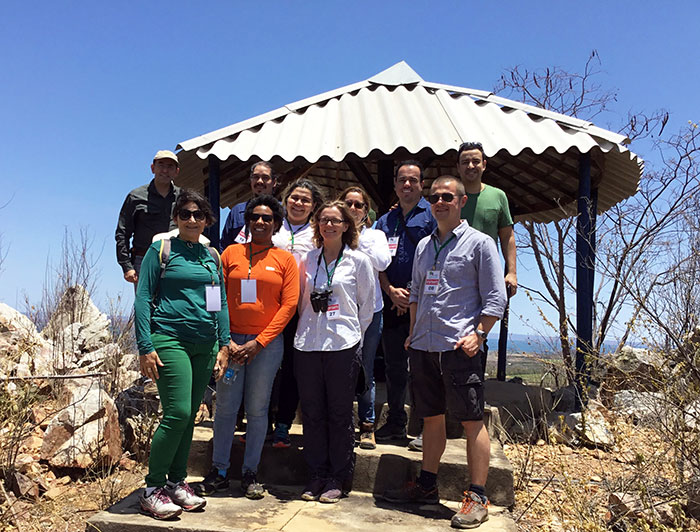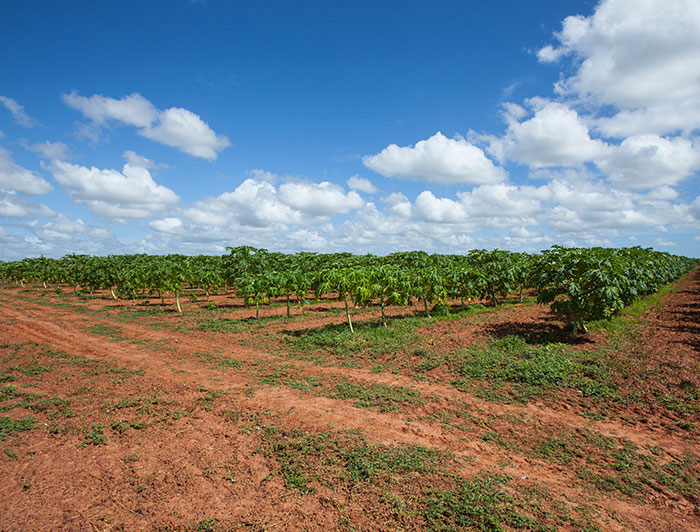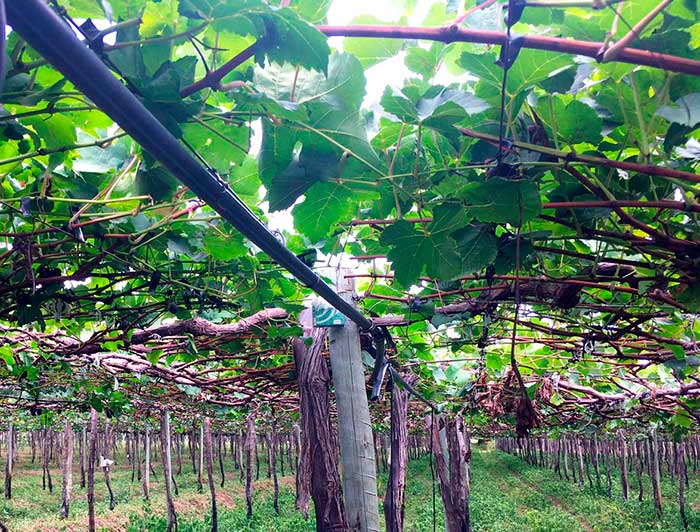Leading the Way: Innovative Project Unlocks the Potential of Sustainable Fruit Farming
The aim of a collaborative effort among Brazilian, British, and Chilean researchers, including UC Chile professor Eduardo Arellano, was to advocate for ecological intensification practices in a region of Brazil deeply impacted by human activities. Over the course of five years, their dedicated work aimed to adapt a novel agricultural production approach within a Latin American framework.

photo_camera Sustainable Fruit Growing in the Caatinga (SUFICA) is a consortium of researchers from universities in the United Kingdom, Brazil, and Chile that sought to improve the sustainability of fruit growing in the São Francisco valley in the Caatinga region of Brazil. (Photo by: Nadia Rojas)
Caatinga is a territory that encompasses about 10% of the total area of Brazil, in the northeast part of the country. Named after its predominant vegetation type (caatinga originates from the Tupí term kaatinga or "white forest"), this ecoregion stands as a singular biome on the global stage. It boasts a distinctive desert flora adapted to arid conditions, featuring an extensive array of trees, shrubs, and bushes. Numerous among these are exclusive to this specific region.
It is also home to hundreds of fruit farmers from the São Francisco valley, who are trying to grow their crops in this semi-arid environment. However, their activity directly impacts this ecosystem. It is estimated that between 1990 and 2010, a tenth of this territory—about 90,000 square kilometers—was lost to agriculture, forestry, and the continuous urban expansion to which it has been subjected, affecting the 500 bird species and 1,000 plant species—31% of them endemic—that inhabit the region.
To address this problem, a group of international researchers led by professors from the University of East Anglia, in the United Kingdom, created in 2018 the Sustainable Fruit Growing in the Caatinga (SUFICA), a consortium that seeks to improve the sustainability of fruit growing taking place in the valley.
International Effort

A joint call from the Chilean National Agency for Research and Development (ANID) and the Newton Fund program of the United Kingdom was launched with the aim of developing associative research projects between researchers from the United Kingdom and Chile that contribute to the economic development and welfare of other countries in the region, under the theme of "Energy-Food-Water-Environment Nexus."
This enabled "the creation of a multidisciplinary and global project that covered the entire production chain involved in the production of agro-food, from production in the garden to sales in supermarkets in England," according to Eduardo Arellano, director of the Chilean chapter of this pioneering project, a professor from the Faculty of Agriculture and Forest Engineering and researcher at the Center for Applied Ecology and Sustainability (CAPES).
- What was the SUFICA project, and how did this collaboration come about?
"The project is an international research consortium, comprised of researchers from Brazil, England, and Chile that sought to improve the sustainability of fruit production in areas of priority for biodiversity, such as the semi-arid Caatinga area in Brazil and central Chile. The project raised several challenges on how to enhance the contribution of the farms to ecosystem services, in order to have food that will not have a negative impact on the biodiversity of the places where it was produced.”
According to the professor, the collaboration was a response to recent market signals in the agri-food sector, especially in Europe, urging farmers to take actions to promote biodiversity.
"The project incorporated the entire fruit supply chain, from farmers in Chile and Brazil to supermarket chains (Waitrose) in England, as well as an industry-led platform that seeks to develop metrics for sustainable agriculture with farm-level use in semi-arid and Mediterranean areas."
- What were the main areas of study/work?
"The research focused on studying and promoting the ecosystem services that enhanced fruit tree production— pollination, carbon storage, and water flow regulation—and assessing the benefits these services bring to the farmers themselves," many of whom, the researcher said, are reluctant to abandon traditional techniques in favor of more environmentally friendly practices.
The project co-designed a series of nature-based innovations in intensive fruit orchards with growers and international exporting companies. "These innovations generate multiple environmental benefits, while improving farm profitability through improved yield or quality and reduced inputs (water and agrochemicals)."
The approach, called "ecological intensification," has shown promise in Europe and North America but had not been tested experimentally in semi-arid tropical environments.
A Sustainable Network for the Future

- What are the main results and conclusions you reached?
"First and foremost, SUFICA allowed us to create a network of researchers, producers, advisors, and exporters from the three countries involved." This was accomplished through organizing 8 workshops in Chile and Brazil, as well as implementing pilot projects with farmers who aspired to improve ecological intensification methods on their farms."
"The main outcome was learning from the co-creation process, where researchers and farmers were brought together to prioritize and adapt the best ecological intensification techniques in their fruit farms. In addition, the online tool for managing farm biodiversity for fruit growing in Mediterranean areas was validated."
"One of the main conclusions is that significant gaps still exist between the practices of fruit growers and the global sustainability objectives. While there is an understanding of what needs to be done in terms of ecological intensification actions that promote biodiversity, there are cultural and social barriers that hinder or prevent the implementation of these practices. Overcoming these gaps will require incentives, such as those in European policies."
- What transfer or dissemination products did this project yield?
"In terms of transfer, seminars were held in Brazil and two seminars in Chile on project progress, ecological intensification actions, and climate change adaptation and mitigation. We also held two closing seminars in Chile, one in Santiago and the other in Rancagua, both of which had a massive turnout.
In terms of dissemination, a series of booklets and manuals were produced in Portuguese and Spanish, describing the region's biodiversity in detail through its birds, mammals, soil fauna, flora, and insects, in addition to a manual on low-impact agricultural practices. We also participated in webinars and online courses.
Finally, in terms of scientific production, we have already published 4 scientific articles, and we are in the process of closing the publications of several more associated with different aspects of biodiversity in agriculture."
Scope and Challenges

- What are the scopes of this project in terms of its future applications in agroecosystems?
"This project reinforces one of the most significant goals of our Center's Ecological Intensification Line, which is the identification and transfer of actions to enhance ecosystem services and biodiversity. We generate relevant information for fruit systems in Chile and Brazil, concerning the potential to adapt management recommendations that are predominantly applied in the northern hemisphere.
Furthermore, the adaptation of the Cool Farm Tool for fruit systems will enable producers to identify actions and generate on-farm biodiversity reports. This is one of the most relevant points, because biodiversity has local aspects that must be validated.”
- What lessons did you learn from this project, beyond these results?
"An important part of the execution of SUFICA was in the midst of the Covid-19 pandemic, so the implementation of the project was a permanent challenge because it involved travel, implementation work, and field monitoring, both in Brazil and Chile. In the end, the collaboration and interest of the farmers and researchers made it possible to achieve the objectives.
For us, the learning experience was the induction into international research networks in biodiversity and agriculture through a large-scale project, operating in three languages and involving a wide range of stakeholders. We learned about the reality of farmers in Brazil in the semi-arid areas of the Caatinga and how global fruit markets influence the decisions farmers make."
- Finally, what remains to be done with this work for future research?
"Within the actions tested, cover crop and raptor perch trials were implemented. Work was carried out and progress was made in the designs and implementation, achieving an initial monitoring phase. However, evaluations of the long-term effects of these interventions on fruit production were left pending.
Thanks to the project, a collaborative network of researchers and students from the University of Cambridge, University of East Anglia, Pontificia Universidad Católica de Chile, Universidade de Sergipe, Universidade Federal da Bahia and Universidade do Valle de San Francisco, was formed, which we hope to maintain actively through other international initiatives."
Along with Eduardo Arellano, the project was led by Lynn Dicks, from the University of Cambridge (UK), with the participation of Fabiana Oliveira da Silva, Kátia Siqueira, Patricia Rebouças, Lúcia Kill, and Vinina Silva Ferreira as co-investigators; Andrés Muñoz-Sáez (CAPES) and Liam Crowther as postdoctoral researchers; Natalia Zielonka as PhD student; Nadia Rojas as field assistant, in addition to Gonzalo Neira y Xavier Baudequin as industry representative members.


